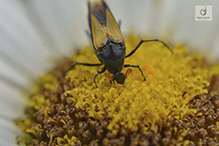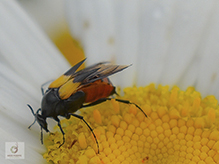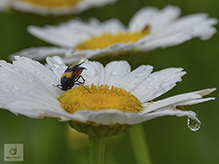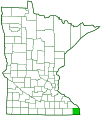Wedge-shaped beetle
(Macrosiagon flavipennis)
Conservation • Description • Habitat • Ecology • Distribution • Taxonomy
Conservation Status |
|||
| IUCN Red List | not listed |
||
| NatureServe | not listed |
||
| Minnesota | not listed |
||
Description
Macrosiagon flavipennis is a parasitic, wedge-shaped beetle. It occurs in the United States east of the Great Plains and in California, in southern Ontario Canada, and in Mexico.
Adults are robust, ¼″ to 7⁄16″ (7 to 11 mm) in length, and mostly dull black.
The head and thorax are entirely black. The head is elongated, directed downward, and strongly constricted behind the eyes, creating a “neck”. The upper surface (vertex) is hairless, rounded, and distinctly elevated above the front margin of the upper thoracic plate (pronotum). The upper part of the face (frons), corresponding to the forehead, is smooth and has a distinct concavity or dimple. The upper part of the mouth (labrum), corresponding to the upper lip, is elongated, rounded at the tip, and hairy. The pair of chewing structures on the mouth (mandibles) are very little curved. There are two oval, small but prominent compound eyes and no simple eyes (ocelli). The antennae have 11 segments. The base of each antenna is near the middle of the inner margin of the eye. On the female the antennae are black except for the first two segments, which are orange, and they have a single, short, forward-pointing projection on each segment (pectinate). On the male they are entirely orange and comb-like, with dense, thick, long projections on both sides of each antennal segment (biflabellate). The projections on both sides are usually pointed forward, making the antennae appear one-sided (flabellate). On both sexes there are no projections on the first two segments.
The pronotum is bell-shaped, longer than the base is wide and narrowest behind the head. The rear corners are acutely angled and a large triangular lobe in the middle covers the plate between the wing bases (scutellum). It does not have a sharp lateral ridge on each side. At the base there is a distinct, raised, fin-like projection (tubercle).
The abdomen on the male is entirely black. On the female the abdomen is mostly orange, black on the last one-and-a-half segments. The hardened forewings (elytra) are strongly pointed and long, as long as the abdomen but not as long as the hindwings. For most of their length they do not touch each other but are separated like an inverted V, exposing the hindwings. On the female they are yellow on the basal half, black on the rear half. The line separating the black from the yellow is semicircular. On the male they are entirely yellow. The hindwings are yellowish-brown.
The legs are long and slender. On the front legs the third segment (femur) is indented at the tip. On the hind legs the femur is distinctly compressed. On the front and middle legs, the last part of the leg (tarsus), corresponding to the foot, has five segments. On the hind leg it has only four segments. The inner surface is smooth and hairless. The second tarsal segment on the hind leg is not flat above, and is as long as the third segment. There is a pair of claws at the end of each tarsus. Each claw is split in two.
Size
Total length: ¼″ to 7⁄16″ (7 to 11 mm)
Similar Species
Habitat
Ecology
Season
June and July
Behavior
Life Cycle
The female lays eggs on flowers. When an egg hatches, the first stage larva (triungulin) attaches itself to the underside of a solitary bee or wasp. After it is carried back to the host’s nest, the triungulin invades the cell of a host larva and enters into the body of the larva. It then delays further development while the host matures. When the host larva is completely developed, the triungulin exits the larva’s body and consumes it and its stored food.
Larva Food/Hosts
Larvae of wasps and bees
Adult Food
Flower nectar
Distribution |
||
|
Sources |
|
| 10/6/2025 | ||
Occurrence |
||
|
||
Taxonomy
Order
Coleoptera (Beetles)
Suborder
Polyphaga (Water, Rove, Scarab, Long-horned, Leaf, and Snout Beetles)
Infraorder
Cucujiformia
Superfamily
Tenebrionoidea (darkling beetles and allies)
Family
Ripiphoridae (wedge-shaped beetles)
Subfamily
Ripiphorinae
Genus
Macrosiagon
Genus Gender
Older and even relatively recent printed literature refer to this species as Macrosiagon flavipenne. Some online sources do so as well, including GBIF and NaturServe. The grammatical gender of the genus Macrosiagon is feminine. Therefore, the species epithet needs to be in the feminine form as well. Flavipenne is the neuter form, while flavipennis is the masculine/feminine form.
Subordinate Taxa
Synonyms
Macrosiagon abdominalis
Common Names
This species has no common name. The common name for the family Ripiphoridae is wedge-shaped beetles, and it is applied here for convenience.
Glossary
Elytra
The hardened or leathery forewings of beetles used to protect the fragile hindwings, which are used for flying. Singular: elytron.
Femur
On insects and arachnids, the third, largest, most robust segment of the leg, coming immediately before the tibia. On humans, the thigh bone.
Frons
The upper front part of an insect’s face, roughly corresponding to the forehead.
Labrum
The upper part of the mouth, sometimes considered the lower part of the face, corresponding to the upper lip, on an insect or crustacean.
Ocellus
Simple eye; an eye with a single lens. Plural: ocelli.
Pronotum
The exoskeletal plate on the upper side of the first segment of the thorax of an insect.
Tarsus
The last two to five subdivisions of an insect’s leg, attached to the tibia; the foot. Plural: tarsi.
Tubercle
On plants and animals: a small, rounded, raised projection on the surface. On slugs: raised areas of skin between grooves covering the body
Vertex
The upper surface of an insect’s head.
Visitor Photos
Share your photo of this insect.
This button not working for you?
Simply email us at info@MinnesotaSeasons.com.
Attach one or more photos and, if you like, a caption.
Mike Poeppe |
||
 |
||
I found these after the rain today just west of Houston. |
||
 |
 |
|
MinnesotaSeasons.com Photos
|

Slideshows
Ontario Wedge-Shaped Beetles (Ripiphoridae)
David Beadle

Visitor Videos
Share your video of this insect.
This button not working for you?
Simply email us at info@MinnesotaSeasons.com.
Attach a video, a YouTube link, or a cloud storage link.
Other Videos

Visitor Sightings
Report a sighting of this insect.
This button not working for you?
Simply email us at info@MinnesotaSeasons.com.
Be sure to include a location.
Minnesota Seasons Sightings



